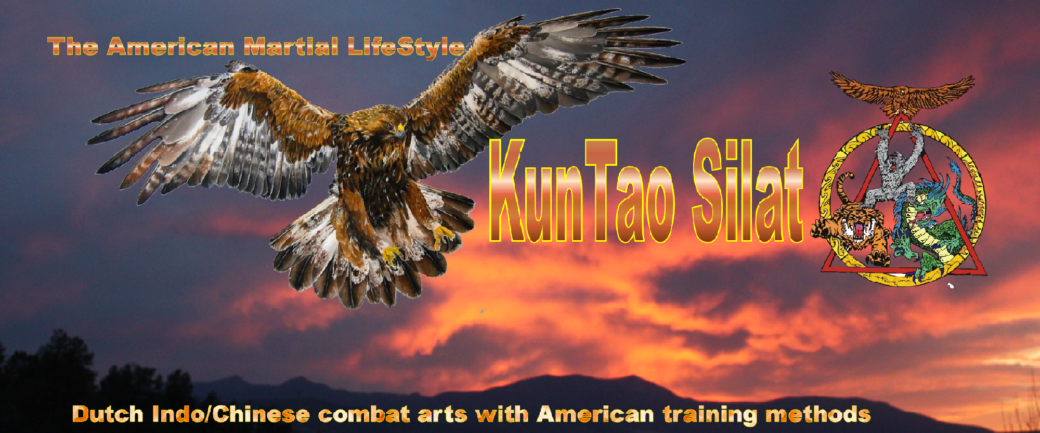The Deadly De Thouars`
Copywrite 1995, Chas Clements
In America, traditionally, fighting with the knife has not been looked upon with favor. We’re a nation of gunfighters; from the Colonial longrifle to the present ‘wondernine’. It has been left to the ‘underclasses’; poor, minorities, the criminal class and immigrants to favor the knife and to hold and teach the methods of using it in combat. In other lands, however, the knife has been the weapon of choice and favor. The Indonesian Archipelago is such a place; land of a thousand languages and cultures. In this culture of masters of the blade, the De Thouars family have carved a place for themselves rivaled by a very few.
Presently, the family consists of the four brothers; Pendekar Agung Paul De Thouars, Great GrandMaster of Serak� Tulen and Bukti Negara, Guru Besar Willem De Thouars, founder of Kun Lun Pai Kun Tao and GrandMaster of Serak�, Maha Guru Victor I. C. De Thouars, Founder of Serak� Tongkat, and Maurice De Thouars, Maha Guru of Silat Serak� in Holland.
In this style, the knife is taught as one of the first weapons. Before one learns to fight with the empty hand, one must learn to protect oneself. The short stick is also favored, as there is one available in almost any circumstance. The attitude of the body is one of reserve, to refrain from extending the body so as not to get something cut off. In some other forms, this would be known as the attitude of the Short Armed Monkey.
The knife of choice would be ‘pisau’; a short single edged utility knife of common pattern. While different kinds of blades require different stylings, the pisau is the most reflective of the empty hand style. The Kris is the knife favored for formal usage, and the Parang is the weapon most used by agricultural exponents. Each of the knives uses a different expression of the same body of art.
One is charged with using all of the knife. this is to say that one should learn to be familiar with the usages and blows generated from the pommel, guard, flat of the blade, spine, edge, and point. As this is your utility knife, it is a blade that you know intimately; length, weight, balance point, edge up or down, seating and reinforcement. Approach the weapon as if it were a tool that you use everyday; you carve, you pierce, you slice. To hold the mind to use the knife as for everyday, in combat.
The referencing method of using animal names and attributes to describe movements of body or attitudes of mind is a favorite means of teaching and memorizing techniques. The animals include; Orang Utan (the old man of the jungle), tiger, snake, horse, and so forth. When we speak of ‘monkey’ footwork, we also speak of Orang Utan, the rock ape or the Hamadryad ape. The footwork is not necessarily that of a capering treemonkey, it can plant the foot solidly and speaks of positioning rather than speed or deception. The hand of the tiger is perhaps not so important as is the attitude of the tiger.
Snake does not hold the Biblical connotation in Indonesia that it does here in the Christian world. The snake is sinuous, full of musculature, he has a penetrating aspect and his touch is poison. He defies Dragon on his own ground.
The Horse strikes without warning, each blow is devastating, because he has four legs he changes position and weight without telegraphing his move. These are only some of the animals and only some of the attributes that we find in them. The observation of the animals, the appreciation of the application by a human in a martial arts manner, accepting the attitudes displayed by animals and reflecting those attitudes in our martial study is an ongoing study.
Pendekar Agung (Revered Champion) Paul De Thouars is a complex man of wonderful talents. Born in Java to a family of champions dating to the early nineteenth century, Raden Mas Paul has fulfilled the promise of his training. An undefeated champion of many bouts on the Kendang (the fighting floor), he has added to the knowledge of the masters passed to him to expand and codify the art of Serak�. His personal study of lines of force and weakness, his understanding of the engineering of the body and the space that it occupies is unparalleled. He is a cheery man, given to dribbling his opponents about the room with an infectious smile on his face.
The arts of Pukulan Pentjak Silat Serak� De Thouars have been forged in the crucible of reality. For many lifetimes, these arts have been tested, refined and tested again. Nothing superfluous has been retained while nothing new has been ignored.


No comments yet.